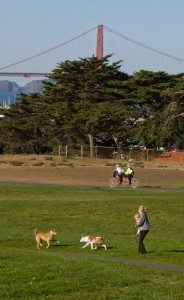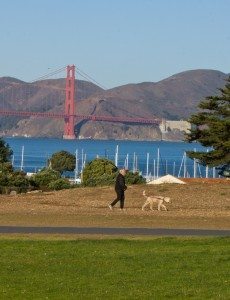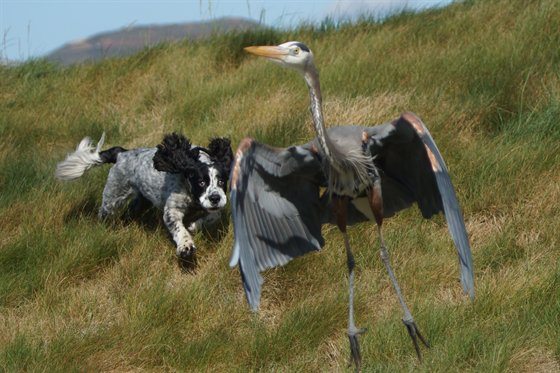Golden Gate Bird Alliance has long advocated for reasonable management of on- and off-leash dogs in the Golden Gate National Recreation Area (GGNRA). Current dog-related recreation is managed under the 1979 Pet Policy, which is not a legal regulation and which fails to protect wildlife, habitat, and park visitors.
In 2013, the National Park Service released its revised proposed Dog Management Rule and Supplemental Environmental Impact Statement (SEIS) to manage dog-related recreation in the GGNRA. The proposed rule is the biggest accommodation for on- and off-leash dogs in the National Park System.
The proposed Rule allows for four off-leash dog areas and 21 miles of on-leash dog recreation in the San Francisco portion of the GGNRA. No other National Park allow off-leash dogs, and most limit on-leash dogs to a few paved trails.

Golden Gate Bird Alliance supports better regulation of dogs in the GGNRA. While we believe that the proposed regulation is a good first step, the proposed rule does not adequately protect park resources.
We encourage you to share your opinions and experiences with the National Park Service. Click here to file an online comment. The NPS is accepting comments through February 18, 2014.
In our comments, we will emphasize the following points:
- The GGNRA should provide more opportunities for visitors to recreate in the GGNRA in San Francisco without interacting with dogs. Currently, the Preferred Alternatives only provide a few areas where visitors, including those with small children, may go without having to interact with dogs. Many parents and grandparents have told us they will not take children to areas where there are many off-leash dogs. This is not fair to community members that have a right to enjoy the park without fear or discomfort due to the presence of dogs.
- Off-leash areas should be well defined by a physical barrier. Park visitors should have the choice of interacting with dogs during their park experience, rather than having the choice made for them. Clearly defined on- and off-leash areas will allow dog owners and other visitors to know where dog-related recreation is appropriate. It will also better protect sensitive wildlife and habitat resources, reduce conflicts with other users, and allow for less controversial enforcement of the new rules.
- The SEIS fails to establish that “voice control” is a valid method of controlling off-leash dogs. The National Park Service records hundreds of Criminal Incident Reports relating to out-of-control dogs each year; often, the dog owners and walkers do not have any voice control over their dogs. The SEIS provides no evidence that voice control is a valid method for controlling dogs or protecting people, natural resources, or other dogs within the GGNRA.
- Commercial dog walking should not be included as a component of the Preferred Alternative. Commercial dog-walking constitutes an economic use of park lands that is not permitted by the National Park Service’s Organic Act, the GGNRA enabling legislation, the National Parks Omnibus Management Act of 1998, the National Environmental Policy Act, NPS Management Policies 2006, and Director’s Order #53. Commercial activities within the National Parks are allowed only to the extent that they support the park mission to protect resources and enhance the visitor experience. Commercial dog-walking constitutes a use of the public land that puts a drain on park resources without any financial or mission-oriented returns for the Park Service.
- Park visitors should be limited to two dogs per visitor. On trails, visitors with more than two dogs have a wider space requirement and have the potential to impact other park visitors by disrupting or impeding their progress along the trail. In off-leash areas, few dog owners or walkers are capable of exerting voice control over one or two dogs, let alone more than two at the same time.
- A simple and effective violation reporting system should be established. The Dog Management Plan should include a means by which park visitors can easily and effectively report non-compliant behavior.
Background
In 1972, the GGNRA was formed from a variety of public and private lands, all of which had different policies about dogs. As a result, GGNRA became the only national park in the country to allow unleashed dogs and allowed on-leash dogs on unpaved trails throughout the park.
In 1979, the National Park Service adopted a Pet Policy aimed at governing where dogs were allowed, both on-leash and off-leash. But the Pet Policy was not created as legal regulation and had no environmental review or public comment.
Over the decades, the GGNRA has become overwhelmed by significant increases in the number of visitors and visitors with dogs. Dog-related recreation has been identified to have a significant and growing impact on the park’s resources. The Park Service determined that it had to better regulate dog-related recreation to protect park resources, visitors, park personnel, and wildlife.
A Need for Regulation


Dogs and dog-related recreation has significant impacts on wildlife, habitats, and park visitors within the GGNRA. (1) It is not just wildlife that are affected. Every year Park Service rangers record hundreds of incidents of dogs attacking or assaulting people (2), wildlife (3), and other dogs (4).
While a dog chasing shorebirds may seem like harmless, good fun, the shorebird is under extreme stress from what it sees as deadly predator.
Harassment of birds protected by the Endangered Species Act is against the law (5). It is also inhumane—birds and other wildlife deserve to have space in the GGNRA where they can rest, forage, and live without constant disturbance and fear of death.
While many dog owners are conscientious, many others fail to comply with leash requirements in certain areas, to clean up after their dogs, or to maintain voice control over their off-leash dogs. For example, GGBA volunteers monitoring Snowy Plovers at Ocean Beach and at Crissy Field have recorded that dog owners comply with the requirement to keep dogs leashed in the plover area less than 30% of the time. The Park Service’s Criminal Incident Reports record numerous instances where owners are unable to prevent their off-leash dog from attacking people, wildlife, or other park users.
Recognizing these impacts were impairing the park, the National Park Service is required by law to implement better regulation. The Park Service’s mission statement states:
The National Park Service preserves unimpaired the natural and cultural resources and values of the national park system for the enjoyment, education, and inspiration of this and future generations.
Moreover, National Park Service Organic Act, which created the Park Service, mandates:
The service thus established shall promote and regulate the use of the Federal areas known as national parks, monuments, and reservations hereinafter specified by such means and measures as conform to the fundamental purpose of the said parks, monuments, and reservations, which purpose is to conserve the scenery and the natural and historic objects and the wild life therein and to provide for the enjoyment of the same in such manner and by such means as will leave them unimpaired for the enjoyment of future generations.
(16 U.S.C. 1). Any recreational activity within a national park must not impair the park for the enjoyment of current or future generations.
Golden Gate Bird Alliance believes that the National Park Service must move forward with the proposed Dog Management Plan to ensure that all park users get to enjoy every aspect of the park in the future.

References
1. See, e.g., Lafferty .D. 2001. Disturbance to wintering western snowy plovers. Biological Conservation. 101: 315-325 (finding that dogs were a “disproportionate source of disturbance” for snowy plovers); Lenth, B. et al. 2006. The Effects on Dogs on Wildlife Communities. 2006. Research Report Submitted to City of Boulder Open Space and Mountain Parks, available here. (“The presence of dogs along recreational trails correlated with altered patterns of habitat utilization by several wildlife species.”); Banks, P.B. and J.V. Bryant. 2007. Four-legged friend or foe? Dog walking displaces native birds from natural places. Biol. Lett. (2007) 3, 611–613, available at http://rsbl.royalsocietypublishing.org/content/3/6/611.full.pdf (finding that dog walking resulted in a 41% reduction in the number of birds detected and a 35% reduction in species richness).
2. See, e.g., Criminal Incident Records prepared by the U.S. Dept. of Interior rangers for incidences in the GGNRA of dogs attacking or harassing human visitors in the park, including reports on 1/17/08 (dog bit horse on the muzzle, causing it to rear and fall over and, when freed, ran away into the ocean in a panic), 4/21/08 (in which a dog owner tried to separate his dog from an attacking pit bull and had been bitten, requiring medical attention; both dogs had been off-leash), 8/16/08 (child bitten in face by off-leash dog, requiring medical attention), 9/23/08 (woman hiking attacked and bitten on the hip), 9/24/08 (two women were harassed by a large, aggressive dog and the owners failed to call the dog off before giving up, letting the dog continue to harass them), 10/23/08 (dog made physical contact with a juvenile female, leading to a physical altercation between the girl’s father and the dog’s owner), 10/25/08 (two dogs attacked dog belonging to 75 year-old woman, biting her twice; attacking dogs’ owner fled scene); 11/21/08 (man bitten by dog while hiking on a trail), 12/5/08 (dog attacks mounted park ranger), 12/30/08 (dogs attacked a horse causing it to throw its rider, then chased the horse down the beach). See also U.S. Center for Disease Control (2003). Nonfatal Dog Bite–Related Injuries Treated in Hospital Emergency Departments — United States, 2001. Available at http://www.cdc.gov/mmwr/preview/mmwrhtml/mm5226a1.htm and http://www.dogsbite.org, a web-based clearing house of information for dog-related attacks in the United States.
3. See, e.g. Criminal Incident Records prepared by U.S. Dept. of Interior rangers for incidences in the GGNRA of dogs chasing wildlife, including citations on 1/6/08 (“off-leash dog chasing birds in the dunes”), 3/5/08 (“dog chased nesting shorebirds…it ran more than 200 yards away from the dog walker and beyond any control for at least fifteen minutes.”), 3/7/08 (“The pet was unattended and not under any control as it continually ran through the designated Wildlife Protection Area chasing birds.”), 3/14/08 (owner of dog chasing birds explained, “He’s a Pit Bull, likes birds, and needs something to chase.”), 10/28/08 (“small dog running off leash jumping at flying birds”), and 12/15/08 (two large dogs flush a group of ducks from the shore into the water and then forced them to take flight). These are only a small sample of reported incidences of harassment of wildlife in 2008 alone, which are in turn a small subset of total disturbances to wildlife, most of which are unreported.
4. See, e.g., Criminal Incident Records prepared by the U.S. Dept. of Interior rangers for incidences in the GGNRA of injuries to dogs, including 2/08/08 (small dog “overpowered” and bit “multiple times” in the face and neck by off-leash dog), 4/20/08 (dog stuck on a cliff, requiring officers to perform a rescue), 5/31/08 (small dog attacked by pit bull, owner sustained injuries separating the dogs), 10/08/08 (dog fight occurred after professional dog walker failed to keep control of dogs), 11/22/08 (off-leash dog ran into roadway, colliding with a motorcycle and throwing the rider, requiring medical attention for the rider and dog), 12/30/08 (dog suffered “deep” laceration after being attacked by off-leash dog). These are only a few examples from 2008 of reported incidents in the GGNRA, which we know are a small subset of total incidents of this kind.
5. See USFWS. 2007. Recovery Plan for the Pacific Coast Population of the Western Snowy Plover, at 65).

